It’s fourth time lucky for the UK Very Light Rail Conference – organised by the Black Country Innovative Manufacturing Organisation (BCIMO) and partners.
On Thursday 16 June 2022, it was fourth time lucky for the UK Very Light Rail (VLR) Conference after three unfortunate postponements due to COVID. The Black Country and Marches Institute of Technology (IoT) in Dudley hosted the event, neighbour and partner institution to the Very Light Rail National Innovation Centre (VLRNIC), a new £32 million investment designed to advance the fast-growing VLR industry.
The VLRNIC has been constructed thanks to funding from the Black Country Local Enterprise Partnership (BCLEP), the Coventry and Warwickshire Local Enterprise Partnership (CWLEP), and the European Regional Development Fund (ERDF). It will officially open later this year, but the test track is already open for certain types of business, such as vehicle testing – full details available soon.
A total of over 300 in person and virtual attendees either turned up or tuned in, with live streaming services provided by Associate Events. Corin Crane, then Chief Executive of the Black Country Chamber of Commerce, facilitated the jam-packed and hugely successful event, featuring:
OPENING VIDEO
Celebrating the History of Rail innovation and development in the UK, culminating in the imminent opening of the VLRNIC.
KEYNOTE SPEECHES
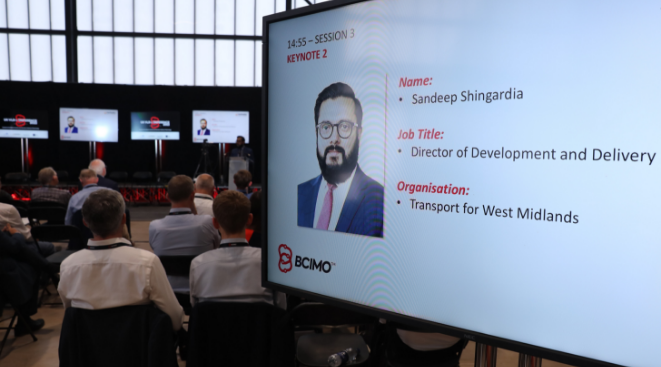
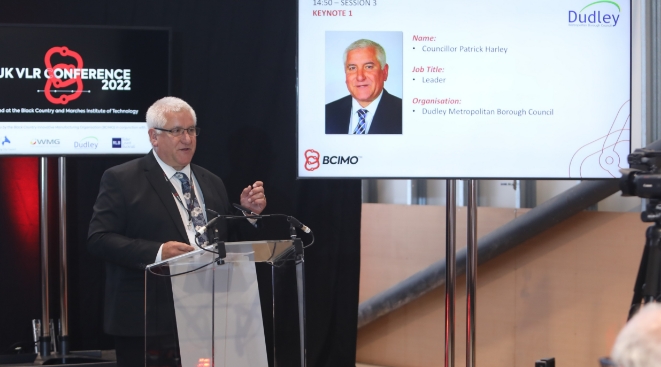
From Andy Street, Mayor of the West Midlands Combined Authority, Baroness Vere of Norbiton, Parliamentary Under-Secretary of State for Transport, Margot James, Executive Chair of WMG, University of Warwick, Sandeep Shingadia, Director of Development & Delivery at Transport for West Midlands, and Councillor Patrick Harley, Leader of Dudley Council.
presentations from:
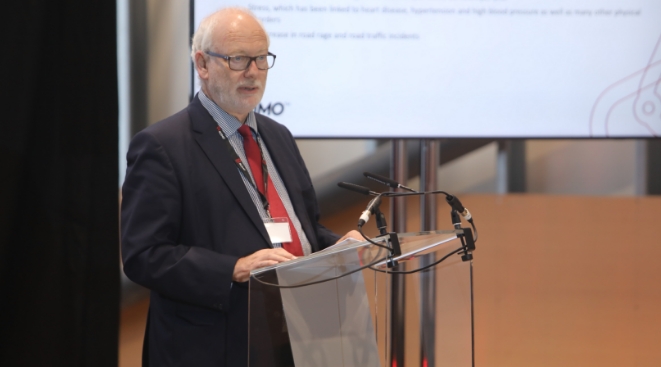
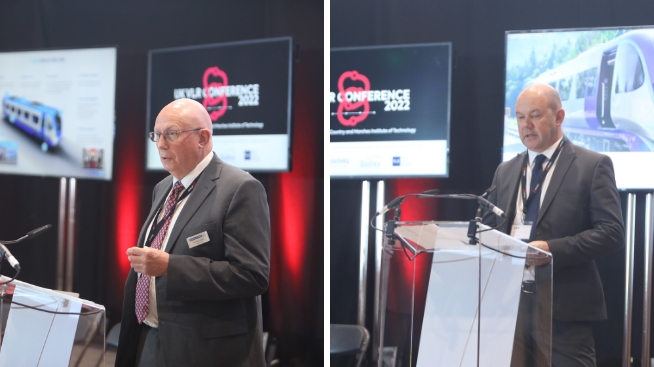
Dr Nick Mallinson, Chief Executive Officer at the Black Country Innovative Manufacturing Organisation (BCIMO), who presented a compelling case for VLR, describing the political, environmental, sociological, technological, legal, and economic drivers for change. In addition to outlining the key features and benefits of VLR, he explained how it can be deployed in Urban, Rural and Land Development settings as part of wider end-to-end or Hub-to-Home journeys.
Tim Burleigh, Head of External Relations at Eversholt Rail and Darren Smith, Group Commercial Director at Transport Design International (TDI), who presented Revolution VLR (RVLR), a hybrid powered and zero emission capable vehicle, suitable for Rural and branch line feeder applications. The project aims to create new, RVLR exclusive, assembly facilities in the Midlands within the next 12 months and have RVLR vehicles built and approved for
passenger-carrying operations by 2024.
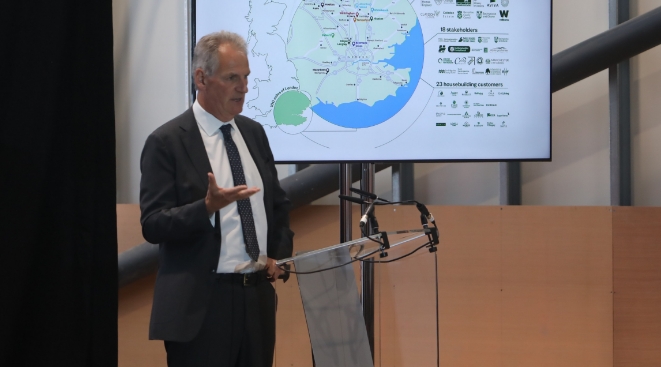

Robin Butler, Managing Director at Urban & Civic, master developer of large-scale Land Development sites. Robin explained the current difficulties in integrating with heavy rail and how these impact on site selection and delivery timescales. His view is that accelerated rail integration is fundamental to the achievement of the Government’s ambitious house building targets and that VLR offers an enormously attractive opportunity to enable that.
Martin Pemberton, original founder of TDl talked about the evolution of the VLR concept. The journey began back in 1995 with the development of the Minitram, a battery powered, electronically guided, urban tram. Since then, TDI has been involved in a series of projects, culminating in the design, build and testing of both the RVLR and Coventry VLR vehicles. TDI continues to work with the RVLR project to achieve its aims.
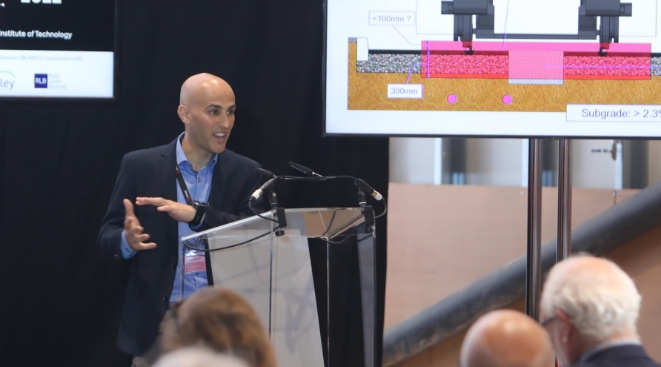
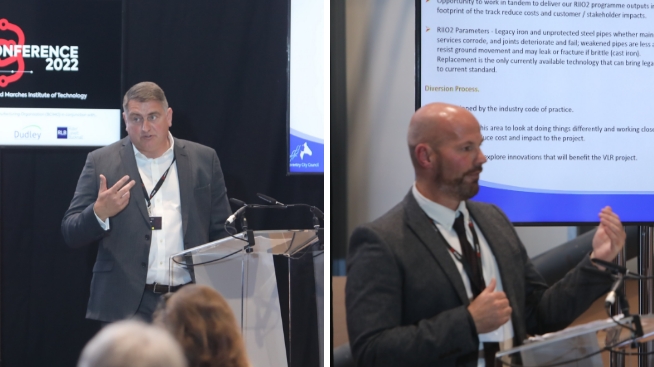
Dr Christopher Micallef, Principal Engineer at WMG, University of Warwick, who gave an overview of the work to develop the CVLR track system. With a total depth of 30cm, the new track form has been designed to enable a radical system cost reduction (£10m/km, as opposed to recent traditional light rail costing in excess of £40m/km) and reduce project delivery duration and complexity (limited diversions of utilities). Next steps are to pilot the track at 3 different sites, including a 60m stretch at the VLRNIC.
Wayne Cockrell, Independent Utility Consultant and Andrew Shore, Design Manager at Cadent Gas. Wayne explained how utility companies have a statutory right to access buried apparatus and the process of the Transport Works Act Order (TWAO). He also described the two factors in a decision to divert; physical clash or a loss of access, both of which the CVLR track form seeks to avoid. Andrew then talked about the work Cadent Gas is doing with the CVLR project and the innovation opportunity this presents.
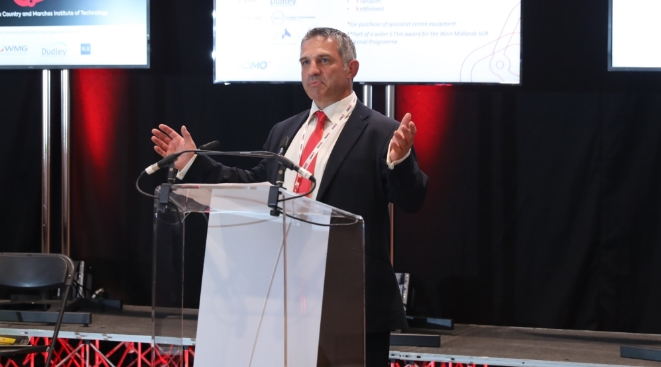
Anthony Joy, Head of Engineering and Programmes at BCIMO, who described how BCIMO aims to take a collaborative approach to support the development of future public transport markets, technologies, supply chains and workforces. Tony outlined BCIMO’s service offerings within each of these areas, including the facilities available for hire at the VLRNIC, and used the analogy of a cog wheel to illustrate how each element links together to deliver the bigger picture.
Interview sessions
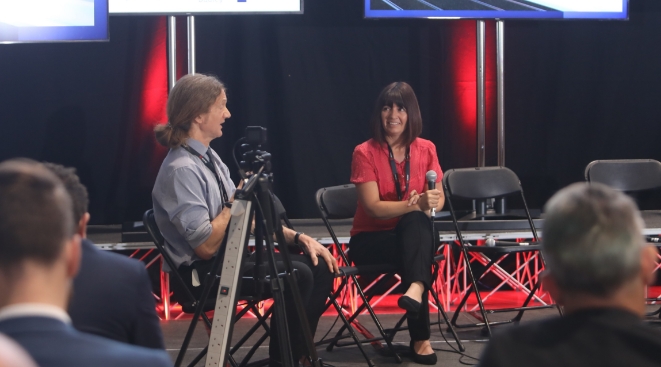

Colin Knight, Director of Transportation and Highways and Nicola Small, Senior Rail Programme Manager, both at Coventry City Council, who answered questions about CVLR, the breakthrough system designed to make Urban light rail installation affordable for small to medium sized towns and cities. They explained the key drivers for the project; reduced cost, improved connectivity, and economic growth, and announced Coventry’s plans for a city
centre demonstrator in 2024 / first route in 2026/27.
Dr James Meredith, Project Manager, and Dr Graham Lee, Principal Engineer, both at WMG, University of Warwick. James and Chris explained how the CVLR project continues to transfer technologies from the automotive sector, with a roadmap taking the system to 2030 and beyond. System integration and automatic operation are the 3rd pillar, and the aim is to achieve Grade of Automation 4 (GOA4), offering benefits in terms of capacity, cost, safety, comfort, and efficiency.
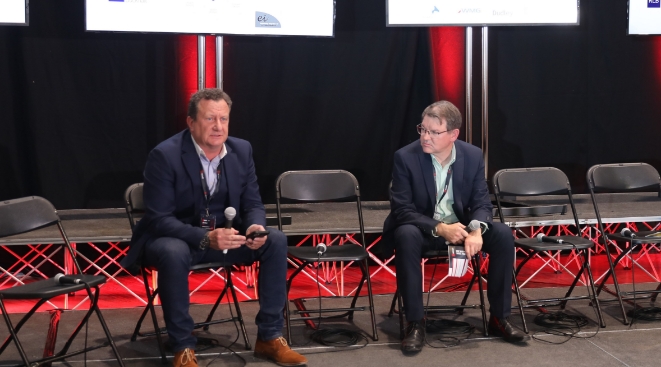
Andrew Stamps, National Head of Infrastructure at Rider Levett Bucknall and Julian Mason, Director at Engineering Integration both answered questions about their roles in BCIMO’s Advice Centre which will launch in the coming months. The aim of the Advice Centre is to provide early impartial and non-solution specific advice and high-level feasibility assessment to local authorities and other groups considering a VLR scheme.
site tours
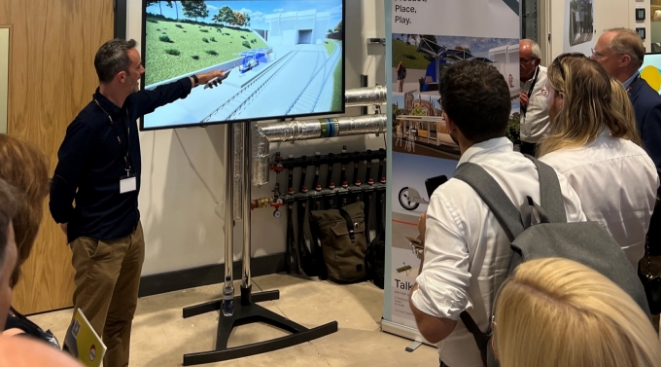
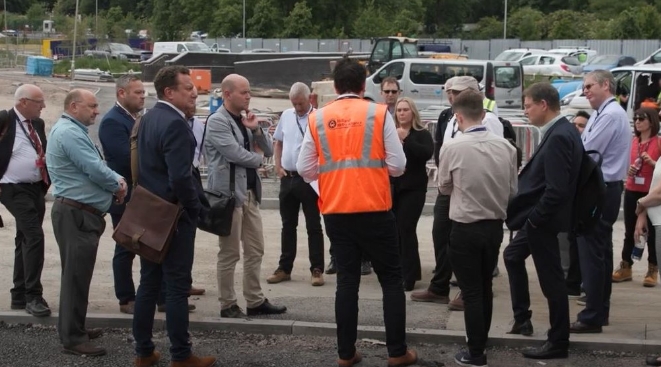
The Wednesbury to Brierley Hill Metro Extension, which is under construction by Midland Metro Alliance. The extension follows the old South Staffordshire railway alignment, breaking off when it reaches the VLRNIC to run through Dudley’s town centre, before re-joining the railway alignment at the southern end of the test track. An adjacent tram stop will provide direct access to the VLRNIC, and the potential for a connection into the centre for tram modifications is currently being discussed with Transport for West Midlands.
VLR Mobility Hub Prototypes, designed by Quarterre. The concept is for a modular design that can be scaled up or down, depending on location and anticipated footfall. It features Solar PV glass to power LED lighting and a series of discrete, integrated mounting points that allow additional equipment, sensors, and services to be easily connected. As such, it enables passengers to seamlessly change from one mode of transport to another. A prototype mobility hub will be located adjacent to the VLRNIC test track later this year.
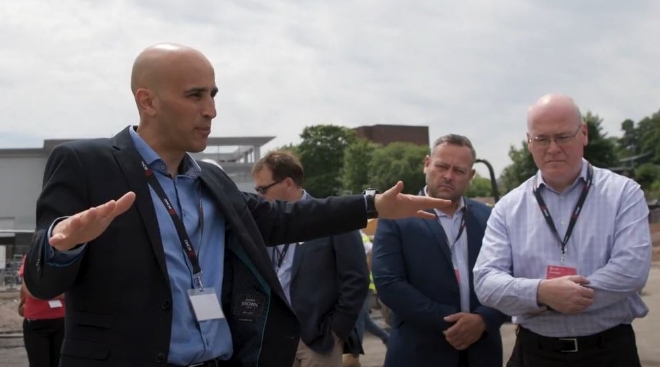
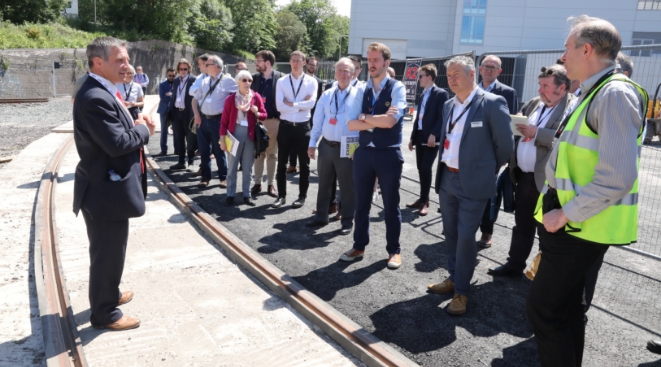
The CVLR track form, developed by WMG, University of Warwick and Ingerop. The novel slab-based system was designed against a unique set of requirements and developed over a two-year period of research which aimed to achieve holistic strategic advantages. The high-integrity slab allows the loadings to be spread efficiently over an ‘unprepared’ foundation hence only requiring a real-world dig depth of 300mm. The slab also enables flexible location of the rail allowing route designers to deliver an urban route using just one slab shape.
The 15m radius loop, built to test the CVLR prototype vehicle’s cornering system, designed to handle tight corners in Coventry’s city centre. The loop currently uses standard rail track, however, as part of the CVLR track development project, a section will be replaced with the new novel track form later in 2022. The results obtained from testing the track together with the prototype vehicle in this setting will inform the overall track pilot study.
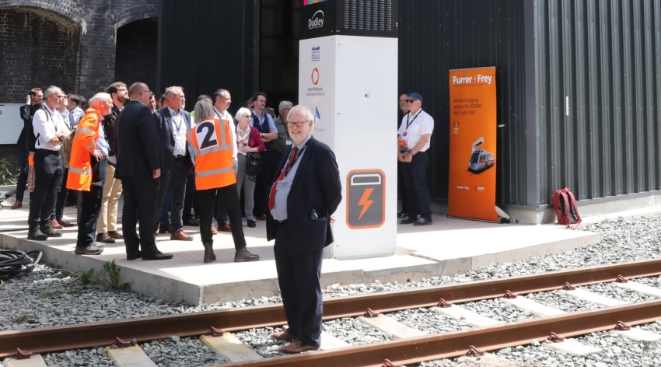
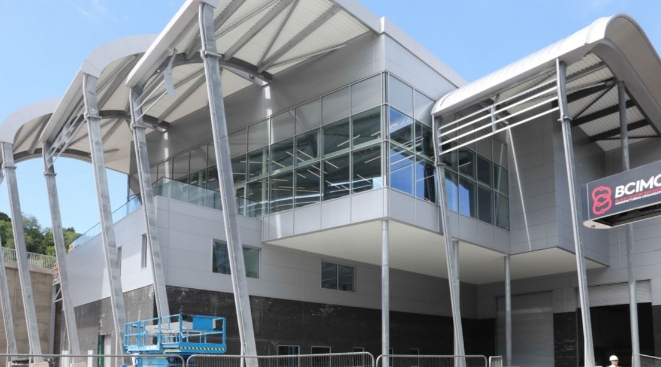
The VLR Rapid Charge Station, developed by Furrer+Frey GB. The charger has recently undergone commissioning at the VLRNIC, enabling the CVLR vehicle prototype to begin testing its automated, rapid charging capability. The adapted, 450kw overhead bus opportunity charger can top-up battery powered VLR vehicles in an estimated 3 minutes, using a pantograph that lowers from above, rather than one fitted on the roof of the tram. The charger enables VLR vehicles to be charged at scheduled stops or at the ends of routes.
The VLRNIC building and test track. The innovation centre, which will be handed over to BCIMO in August 2022, includes a triple height Engineering Hall, a number of research laboratories (to be kitted out over the next two years), a 100-seat Auditorium and a large Exhibition Space, as well as offices and meeting rooms. The 2.2km test track splits into 3 zones and includes a number of features including an 870m tunnel, a short siding, and 2 split-level platforms (one at either end of the track).
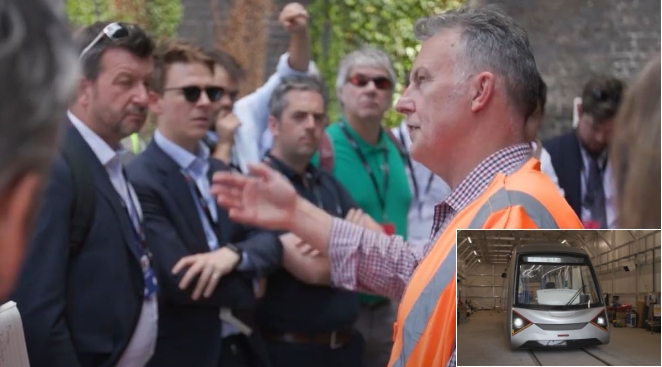
The CVLR vehicle, developed by WMG, University of Warwick and TDl. The vehicle is battery electric and requires no overhead line equipment. At 11 tons it is also lightweight, enabling a much lower cost standard gauge track form to be used. It has capacity for 56 passengers and an estimated range of 70 km. Innovative bogies enable it to operate on 15m radius curves and its traction and wheel slide capabilities eliminate the need for sanding. The prototype vehicle will shortly be handed over to Coventry for further test work at the VLRNIC.
BREAKOUT SESSIONS
Led by each of the application area speakers:
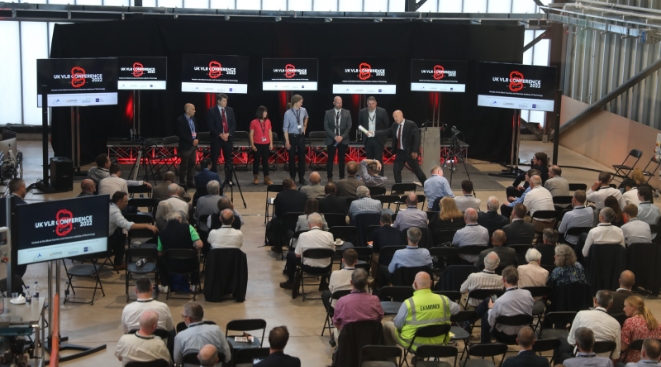
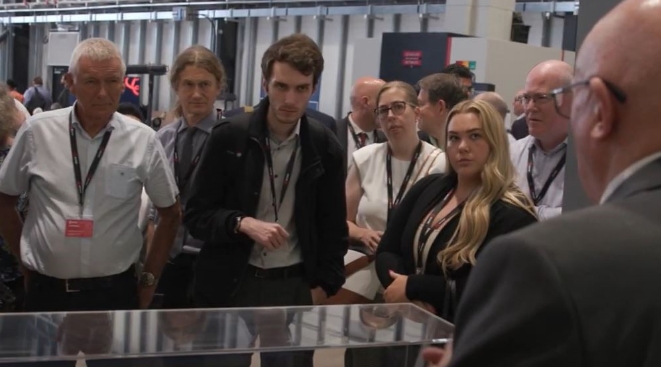
Urban VLR was the most popular breakout session with over half of all attendees gathering to discuss how it could adapt in the future. Facilitated by Corin Crane, delegates questioned speakers from Coventry City Council, WMG, University of Warwick, and Cadent Gas, keen to learn more about plans for urban VLR in more cities, progress on the CVLR project, and on how VLR can be integrated into existing transport networks.
In the Rural and branch line VLR breakout session, attendees considered what the opportunities and existing barriers are for the VLR sector in the UK. There were clear opportunities listed for supporting the environment, economic growth, and the overall cost effectiveness it will bring with more capacity available. The barriers were as expected, the fear surrounding change and new ways of doing things, coupled with the existing red tape which needs to be resolved.
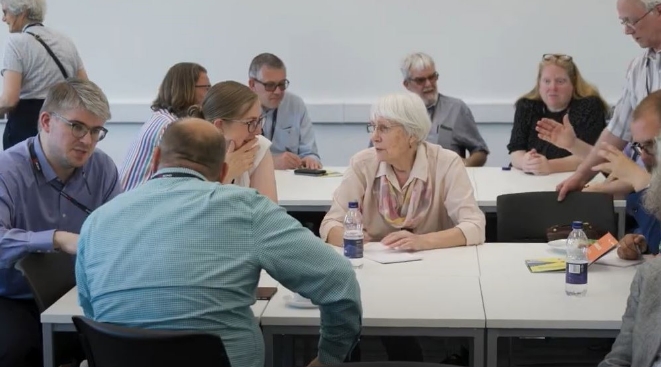
In the Land Development breakout session, attendees considered approaches for funding rail-based infrastructure, including expansion of Community Infrastructure Levy (CIL), restructuring of Section 106 tariffs and Land Value Capture (LVC) for well-planned infrastructure. It was largely agreed that improvements in the transparency, reliability, and speed of government processes relating to large-scale infrastructure were both imperative
and achievable.
WORKING IN PARTNERSHIP SESSION
In which each of the 5 members of the VLR collaboration; BCIMO, Dudley Council, Transport for West Midlands, WMG, University of Warwick and Coventry City Council, took it in turn to express their unwavering commitment to the successful development of VLR in the West Midlands region and beyond.
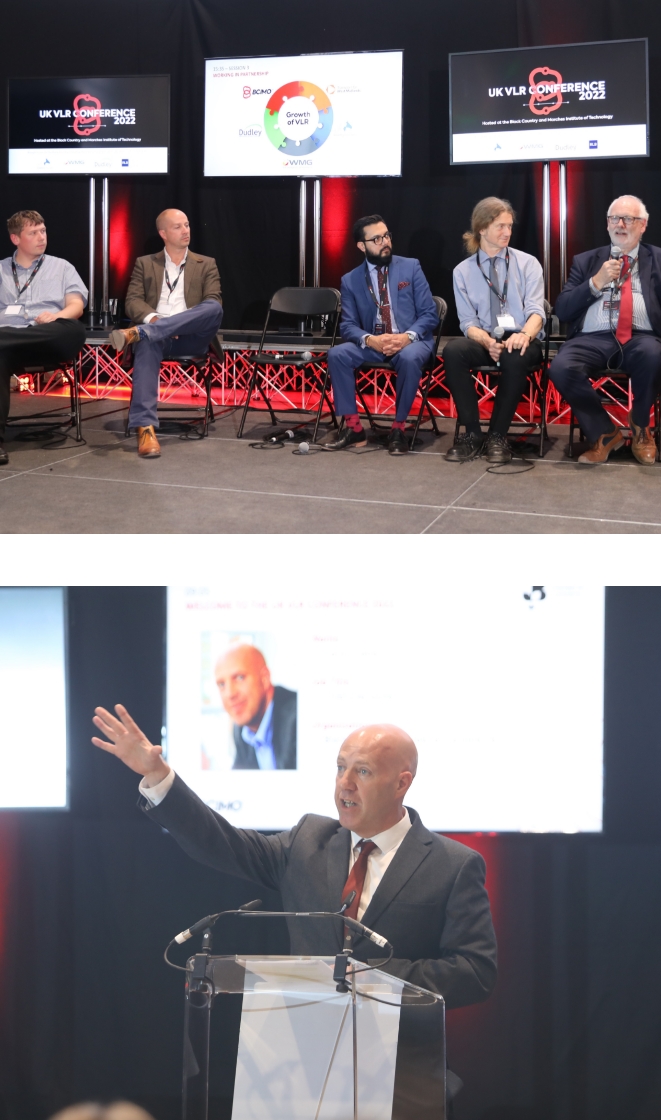
The event concluded with resounding applause from the audience, and has since received rave reviews, including the following:
“Delighted to attend the UK Very Light Rail conference in Dudley yesterday, which showcased the exciting work of our multi-million pound Very Light Rail National Innovation Centre. An excellent conference which has stimulated great interest both nationwide and internationally in this game-changing technology. Well done – and looking forward to this becoming an annual fixture in our calendars.”
Kevin O’Keefe, Chief Executive at Dudley Council
“Interesting and thought provoking. I am sure that the VLR-concept will be of interest not only for the UK but for many European countries in the future. As fuel prices increase the need to get this project moving from concept to operational is greater than ever before. Also medium and small cities need and deserve rail transport to provide an attractive mode of transport that can attract new riders and lessen the financial burden of the public’s travel needs.”
Hans Cruz, Director at Sparvagnsstaderna
“The VLR conference 2022 provided an excellent update. I look forward to seeing this system trialled in the very near future as an alternative lower cost public transport solution in urban and semi-rural areas.”
Ian Collins, Development Director, MMA
“It was a pleasure to attend such an engaging and relevant conference that focused on what was actually being done to increase mobility and reduce emissions through innovation.“
Peter Reeves-Toy, Group Director at Tony Gee and Partners LLP
“These are exciting times for UK VLR, we are at a watershed moment in its development if the solutions get certified then this will become the new template for rail construction from urban to connecting to the core rail infrastructure.”
Carl Johnson, Senior Procurement Manager at University of Warwick
“Excellent event and the content was very interesting and really hope the whole concept of the VLR is taken up soon by lots of councils and authorities.”
David Brooks, Board Member at Rail Forum
“An excellent overview of the journey and future of this transformational rapid transport solution – surely a must-have for many urban locations to better manage the challenges of both today and the future.”
Cat Appleby, Membership Manager at Rail Forum
“It is highly appropriate that the conference was held in Dudley, the borough which boasts the UK’s only operating VLR system at Stourbridge. There is no doubt that a timely impetus to VLR has resulted at a time when costs of conventional tramways are subject to intense scrutiny.”
Geoff Lusher, Director at Pre-Metro Operations Ltd
“A great day with good content and very interesting and knowledgeable presenters.”
Patrick Clipperton, Independent Business Development Consultant
“The day was informative and the BCIMO is well positioned to drive VLR both in the UK and globally.”
Alan Hastings, Key Account Manager UK Rail at Altro Ltd
Watch the following videos on our YouTube Channel
To find out more about VLR please contact us

BCIMO is a not-for-profit Research and Technology Organisation (RTO) and operator of the Very Light Rail National Innovation Centre (VLRNIC), a unique, world-class centre for rail innovation based in Dudley in the West Midlands.

Google Map Location: BCIMO
what3words Address: ///shades.glue.tile
Sat Nav: DY1 4AL
Postal Address: BCIMO, Very Light Rail National Innovation Centre, Zoological Drive, Dudley. DY1 4AW
Email: info@bcimo.co.uk
Phone: 07769 586893
